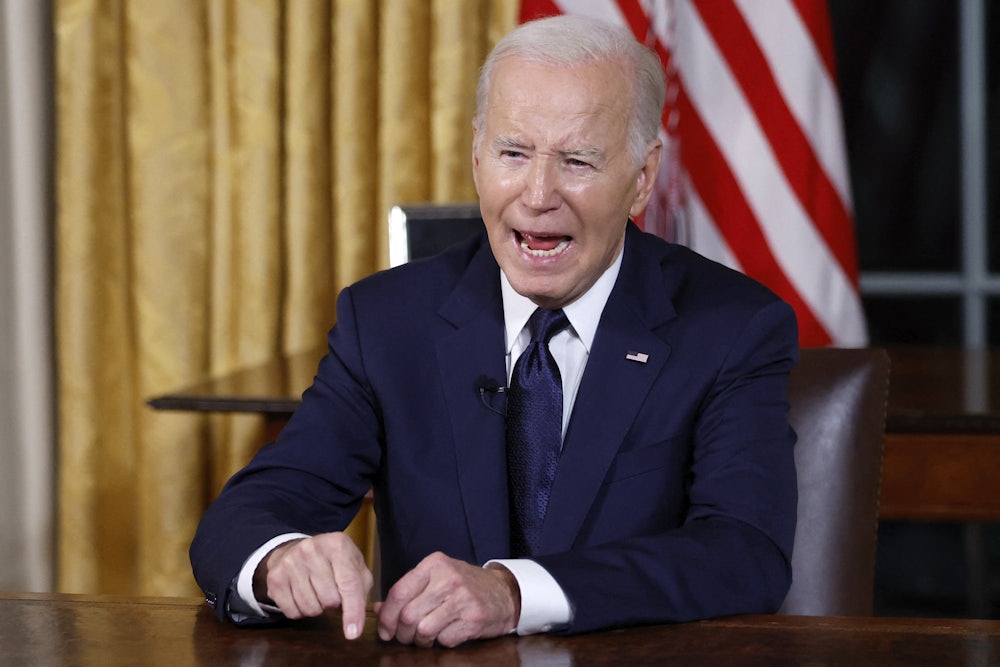In the Middle East this week, world leaders have tensely debated who bears responsibility for the mounting destruction that could claim countless more lives. I’m referring not (at least exclusively) to the escalating war between Israel and Hamas, but a meeting in Aswan, Egypt. Some 700 miles from the Gaza border, United Nations negotiators have been wrestling over how best to finance the rebuilding of countries where lives and livelihoods are being destroyed by the climate crisis—and the United States is playing a familiarly troubling role.
For about as long as the U.N. has discussed climate change, the U.S.—the world’s largest historical emitter of greenhouse gases—has sought to evade questions about nations’ historical responsibility for the crisis. That’s because those questions have tended to have dollar signs attached; as poorer and more climate-vulnerable countries have long argued, the richer countries that are more responsible for the problem ought to pay more to address it. After years of haggling, the text of the U.N. Framework Convention on Climate Change, or UNFCCC, codified a diplomatic consensus in 1992: “In view of the different contributions to global environmental degradation, States have common but differentiated responsibilities.”
Those words have been argued over ever since, particularly on the issue of “loss and damage,” which refers to the cost of recovering from climate-fueled destruction (whether it be extreme weather events like hurricanes or longer-term degradation by, say, sea level rise). Countries in the global south have pushed to establish a dedicated loss and damage fund, similar to those that already exist for climate mitigation and adaptation. Year after year, the U.S. has fought those proposals, fearing it could be on the hook for an ordinate amount of cash. Many were surprised, then, when—during the eleventh hour of last year’s climate talks in Egypt—the U.S. dropped its long-standing opposition to a dedicated fund and agreed to have the U.N. start the process of establishing one.
Members of an internationally representative Transitional Committee tasked with doing that have spent the last year parsing the details of what the fund might look like. Their goal has been to produce a recommendation to bring to COP28, the annual “conference of parties” to the UNFCCC, which begins at the end of next month in Dubai. Having granted an initial concession, the U.S. is now digging in its heels.
In the final hours of negotiations this week, the U.S. continued to insist that the fund be housed within the World Bank. Developing countries have pushed for it instead to be constituted as an independent body like the already established Global Climate Fund, which is housed within the UNFCCC. The U.S. just happens to be the largest shareholder in the World Bank, where overall decision-making power is determined by financial contribution. The Global Climate Fund is governed by a 24-person board, composed of an equal number of representatives from developing and developed countries. As part of a long-standing “gentleman’s agreement,” the U.S. is allowed to pick the head of the World Bank, while the European Union selects the head of the International Monetary Fund. The World Bank’s climate finance has also been delivered primarily as loans, which threaten to add to the enormous debt burdens facing many climate-vulnerable countries.
“The U.S. really wants this to be in the World Bank because the U.S. will have more control,” Brandon Wu, director of policy and campaigns at ActionAid USA, who also heads the group’s international climate justice work, told me over the phone from Egypt. “The U.S. has outsized influence in the World Bank. The U.S. does not like the Global Climate Fund because it is democratically governed and the U.S. can’t control what happens to the money once it goes in there.”
As Cuban diplomat and G77+ China group co-chair Pedro Luis Pedroso Cuesta put it, “We know the history. We know the politics. We know the manipulation.”
As of yesterday, negotiations looked to be approaching a stand-off over the question of where a fund would be housed. As of Friday evening Egypt time, negotiations seemed headed for overtime, past when many delegates’ flights are scheduled to leave. If the Transitional Committee can’t agree on a recommendation this week, the process will get kicked down the road, either to COP28 or to a separate meeting before then.
While Australia and the EU have both supported the idea of putting the fund in the World Bank, neither had been as obstinate as the U.S. on that point, Wu says. “It feels like we are designing a fund that fits into the World Bank, not a fund for loss and damage,” said Diann Black-Layne, Antigua and Barbuda’s ambassador for climate change. “If the World Bank is an option that is not negotiable, then stop negotiating. We don’t need to talk about that here for developed countries to go to Washington and form the fund.” (The World Bank headquarters is in Washington, D.C.)
Wu says he was surprised how little the ongoing war in Israel-Palestine has seeped into negotiations, largely technical talks attended mostly by career negotiators. The other background to this week’s discussions, though, is just how little money the U.S. and other rich countries have actually put toward climate finance.
At the urging of then–Secretary of State Hillary Clinton, wealthy nations in 2009 pledged to, by 2020, raise $100 billion per year to help poorer countries adapt to and mitigate the effects of climate change. That year came and went, and that commitment—which falls well short of actual needs, which are projected to reach between $300 and $700 billion per year by 2030 for loss and damage alone—remains unfulfilled. This week, the White House is sending an emergency security package to Congress that would provide $106 billion to arm Israel, Ukraine, and Taiwan, and further militarize the U.S.-Mexico border. That, President Biden urged in a rare Oval Office address Thursday night, will “help us build a world that is safer, more peaceful, and more prosperous for our children and grandchildren.”
Treasury Secretary Janet Yellen told Sky News earlier this week that the U.S. could “absolutely” afford to support the war efforts of both Ukraine and Israel simultaneously. “America can certainly afford to stand with Israel and to support Israel’s military needs, and we also can and must support Ukraine in its struggle against Russia,” she said. That’s not exactly new information: The $3.8 billion of military aid that the U.S. furnishes to Israel each year well outpaces America’s initial $3 billion commitment to the Global Climate Fund. So far, it has given just $2 billion.
The administration has struck a very different tone on climate finance. There is “not enough money in any country in the world to actually solve this problem,” U.S. climate envoy John Kerry told reporters during last year’s U.N. climate talks in Egypt. “We’re not going to get that kind of money out of any country,” he argued in a separate interview that fall with Bill McKibben. “I was convinced, and I remain convinced, no government is going to solve this problem,” Kerry told an international finance conference in Washington the year before that.
“The cognitive dissonance is unbelievable,” Wu added. “The fact that we can spend billions of dollars on war machines and we have to fight tooth and nail for every few million dollars for climate finance is just an insult. It’d be nice if one of those wars that we were fighting was a war on climate change.”






